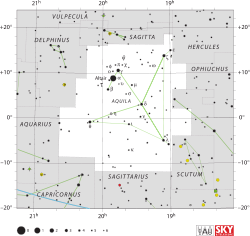36 Aquilae
36 Aquilae (abbreviated 36 Aql) is a star in the equatorial constellation of Aquila. 36 Aquilae is its Flamsteed designation though it also bears the Bayer designation e Aquilae. With an apparent visual magnitude of 5.02,[2] this star is faintly visible to the naked eye. It has an annual parallax shift of 6.17 mas, indicating a physical distance of 530 light-years (160 parsecs) with a 30 light-year margin of error.[1]
 | |
| Observation data Epoch J2000 Equinox J2000 | |
|---|---|
| Constellation | Aquila |
| Right ascension | 19h 30m 39.83606s[1] |
| Declination | –02° 47′ 19.9944″[1] |
| Apparent magnitude (V) | 5.02[2] |
| Characteristics | |
| Spectral type | M1 III[3] |
| U−B color index | +2.03[2] |
| B−V color index | +1.75[2] |
| Astrometry | |
| Radial velocity (Rv) | –10.38 ± 0.55[4] km/s |
| Proper motion (μ) | RA: +20.64[1] mas/yr Dec.: –10.63[1] mas/yr |
| Parallax (π) | 6.17 ± 0.30[1] mas |
| Distance | 530 ± 30 ly (162 ± 8 pc) |
| Details | |
| Radius | 54[5] R☉ |
| Other designations | |
| Database references | |
| SIMBAD | data |
The spectrum of this star matches a stellar classification of M1 III.[3] It is a red giant star with 54[5] times the radius of the Sun that is currently on the asymptotic giant branch.[6] This means the star is generating energy by the fusion of hydrogen along an outer shell and helium along a concentric inner shell, surrounding an inert core of carbon and oxygen. 36 Aquilae undergoes small, periodic variations in luminosity, changing by 0.0063 magnitudes about 11.5 times per day, or once every 2 hours and 5.2 minutes.[7]
References
- van Leeuwen, F. (November 2007), "Validation of the new Hipparcos reduction", Astronomy and Astrophysics, 474 (2): 653–664, arXiv:0708.1752, Bibcode:2007A&A...474..653V, doi:10.1051/0004-6361:20078357.
- Cousins, A. W. J. (1964), "Photometric Data for Stars in the Equatorial Zone (Seventh List)", Monthly Notes of the Astronomical Society of Southern Africa, 23: 175, Bibcode:1964MNSSA..23..175C.
- "* e Aql". SIMBAD. Centre de données astronomiques de Strasbourg. Retrieved 2012-07-22.
- Famaey, B.; et al. (May 2009), "Spectroscopic binaries among Hipparcos M giants. I. Data, orbits, and intrinsic variations", Astronomy and Astrophysics, 498 (2): 627–640, arXiv:0901.0934, Bibcode:2009A&A...498..627F, doi:10.1051/0004-6361/200810698.
- Pasinetti Fracassini, L. E.; et al. (February 2001), "Catalogue of Apparent Diameters and Absolute Radii of Stars (CADARS) - Third edition - Comments and statistics", Astronomy and Astrophysics, 367 (2): 521–524, arXiv:astro-ph/0012289, Bibcode:2001A&A...367..521P, doi:10.1051/0004-6361:20000451.
- Eggen, Olin J. (July 1992), "Asymptotic giant branch stars near the sun", Astronomical Journal, 104 (1): 275–313, Bibcode:1992AJ....104..275E, doi:10.1086/116239.
- Koen, Chris; Eyer, Laurent (March 2002), "New periodic variables from the Hipparcos epoch photometry", Monthly Notices of the Royal Astronomical Society, 331 (1): 45–59, arXiv:astro-ph/0112194, Bibcode:2002MNRAS.331...45K, doi:10.1046/j.1365-8711.2002.05150.x.